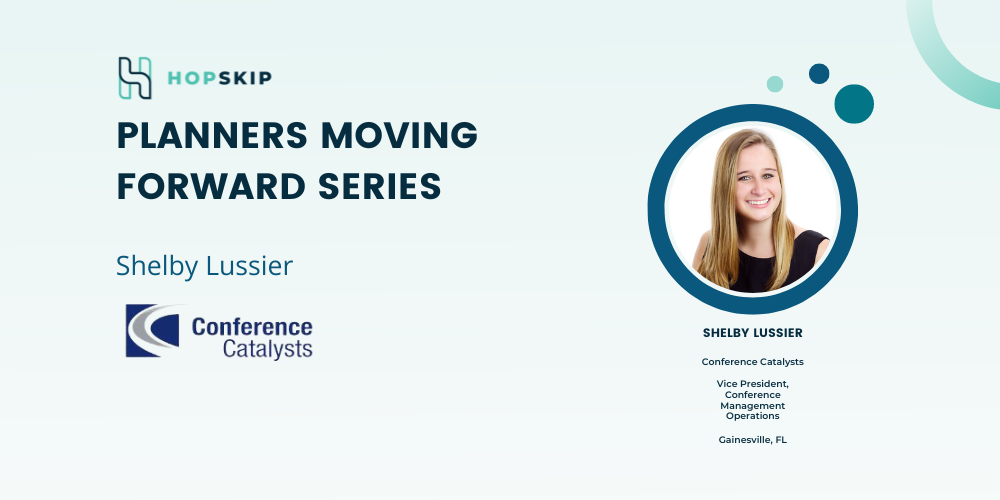This post is part of the HopSkip Planner Spotlight Series where HopSkip spotlight's planners across the industry to bring awareness of how they adapted to COVID-19, communicating and lessons learned and sharing how they are viewing the meetings and events industry in a post-pandemic world.
Name: Shelby Lussier
Company Name: Conference Catalyst
Job Title: Vice President, Conference Management Operations
Years of Experience: 5
How do you think you are positioned, after months of persevering with the pandemic, to take advantage of our new and disrupted meetings/events landscape?
We, at Conference Catalysts, have been able to utilize this new and disrupted meetings/events landscape to better serve our clients and conference attendees. Over the past 2 years we have been able to double our conference client portfolio going from a projected 32 conferences in 2020 to over 60 in 2021 and we are on track to manage another 58 in 2022. With this success, we have been able to also double the number of Conference Managers employed at Conference Catalysts, which we feel is a huge success. One thing that is unique about our client portfolio is that we support many international conferences. As we pivoted to virtual conferences, many of our conferences were conducted in the time zone where the conference was intended to take place onsite. In 2021 alone, we had 60 Conferences take place in 18 different zones. This meant that our Conference Managers were awake at all hours of the day and night to ensure that our clients and events were fully supported. For some, this may sound like a huge hurdle, but our team showed extreme adaptability and endured these challenging hours. In total, we had 217 days of virtual conference sessions in 2021 that our small team was responsible for executing. We are grateful to get to work with so many resilient individuals who were willing to do whatever it took to serve more than 35,000 attendees and provide the best user experience possible.
As our community moves forward with planning in-person meetings, what new technologies or processes are you implementing that you may have not looked at before?
Entering 2020, Conference Catalysts was scheduled to have 40 conferences to execute throughout the year ranging in size from 50 attendees up to 2,500. In total, we were projected to serve over 15,000 attendees throughout the year. As with many conference & event management companies, there was a great deal of uncertainty with our future when the realities of COVID-19 hit in early March 2020. Within a matter of 2 weeks, more that 25% of our client portfolio canceled their conferences outright. Our main focus was to ensure that our clients still experienced a seamless event experience. With that, our digital solutions team was able to create CONFlux. CONFlux is a virtual platform that delivers a streamlined, interactive digital event experience. We have been able to streamline our planning process and give our attendees a better overall experience with this new software. We are eager to continue to utilize CONFlux to provide the best hybrid or on-site experience to our clients and attendees.
As we see virtual meetings transition back to face to face, hybrid meetings are beginning to be the vehicle to return to normalcy. What are your thoughts on hybrid meetings versus traditional fully in-person meetings?
We believe that hybrid meetings are an exciting opportunity for our clients to increase their reach and gain new attendees. While the hybrid events do introduce new challenges such as technology adaptation and budgetary constraints, we are dedicating ourselves to continuing to find the best way to navigate this hybrid landscape and assist our clients.
In your opinion, what do you think the biggest value for your attendees is in regards to returning to live events?
The main item that was always missing during virtual events was the attendee engagement aspect. There's something special about being face-to-face that makes an event much more engaging for all of the attendees. While we have worked hard to replicate this for our hybrid attendees, we are excited to allow our attendees to get back to networking in person.
As the pandemic fades away and we return to face-to-face events what do you hope changes, either for planners or hoteliers, in the traditional RFP and proposal process as a result of all of the learnings from the last 20+ months?
If there was one theme that was constant for our company and this industry throughout the pandemic it was adaptability. We saw firsthand the extra work that our team put in to ensure that these conferences could pivot and be successful in the end. I hope that everyone in our industry keeps the adaptability mindset and realizes how much we are able to accomplish no matter the circumstances that they are given.
This post is part of the HopSkip Planner Spotlight Series where HopSkip spotlights planners across the industry to bring awareness of how they adapted to COVID-19, communicating and lessons learned and sharing how they are viewing the meetings and events industry in a post-pandemic world.
